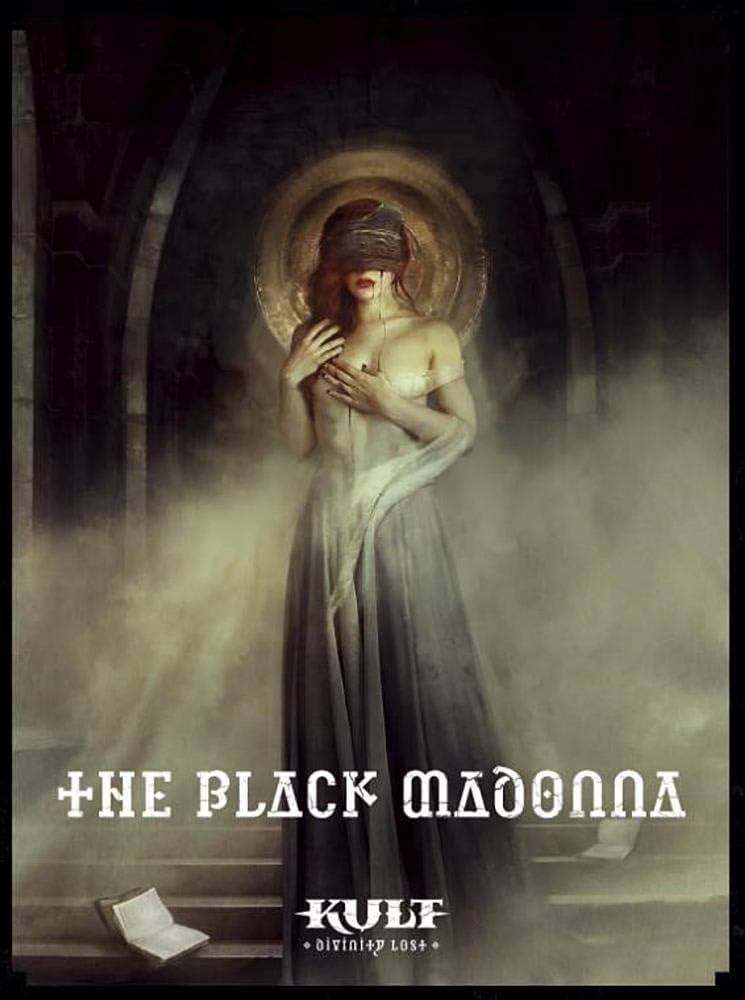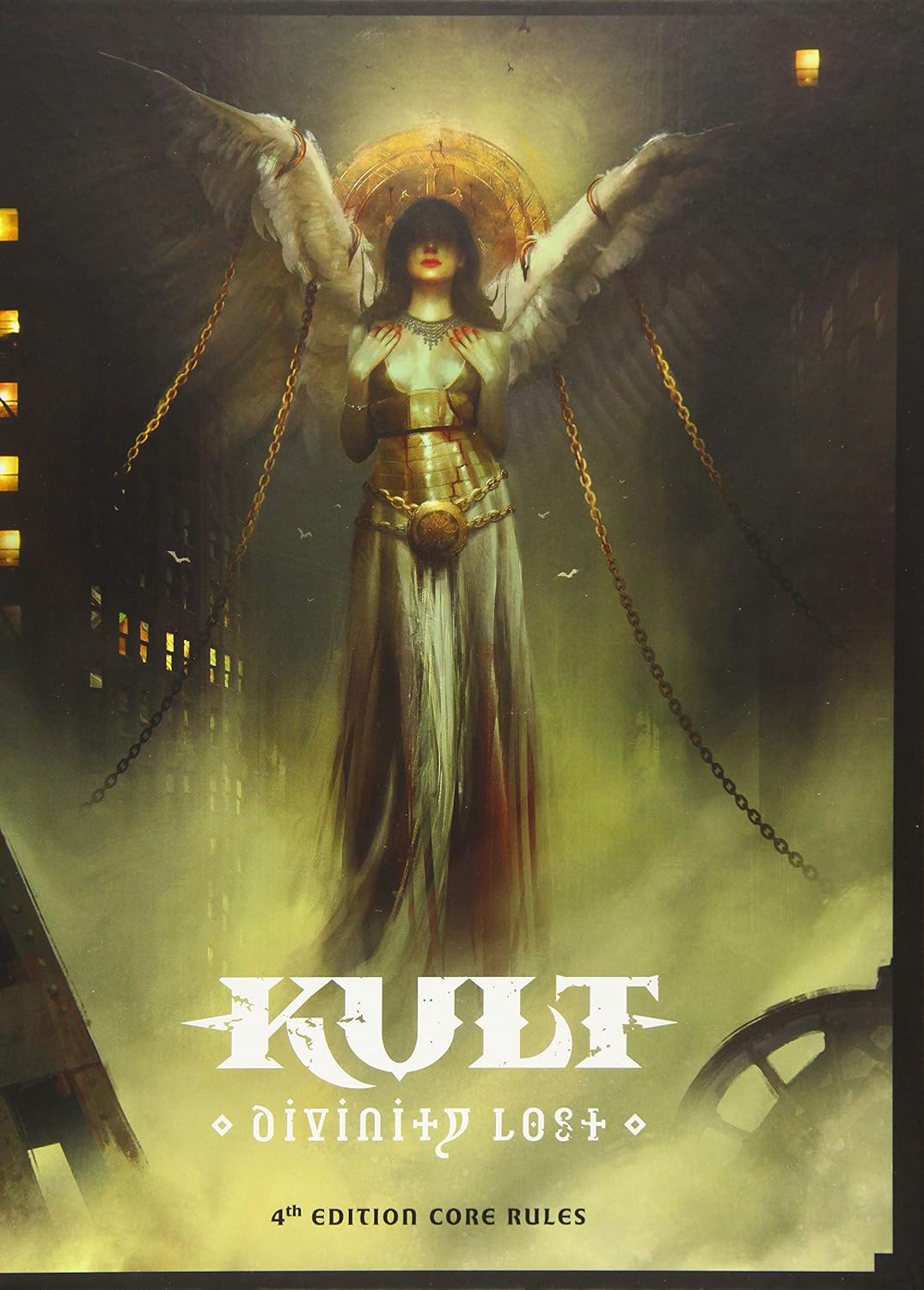If you don’t notice the graphics of the blog you’re at, it is pretty much horror in nature. I’ve been a fan of horror in film, games, literature since I was a child back in the 80’s. In the 90’s and even recently I brought horror to the tabletop in the form of TTRPG’s like Call of Cthulhu and Delta Green or board games like Betrayal on the House on the Hill, Horrified, and Arkham Horror, and yet Kult for decades has past me by.
Kult – Divinity Lost is the 4th edition of Kult a game that had it’s first release in Sweden in 1991 (the same year that Entombed put out Left Hand Path, and Dismember put out Like an Everflowing Stream, something must have been in the water up there). It had an English release in 1993, but it never really took off here, at least until now. The fourth edition was a top-down do-over with the rules taking on a more narrative focused using the “Powered by the Apocalypse” system that has become popular since the 2010 release of the game “Apocalypse World”. Kult – Divinity Lost, is not a straight PbtA game, of course, but it applies elements to its framework and expands upon them.
Now, a primer. Kult could be described as “gnostic horror” so do not think you’re stepping into another variation of Lovecraft’s Cthulhu mythos here. This is something like if Clive Barker took a swipe at the Matrix. A brief version of the background is this, humanity used to be divine and powerful creatures, until the demiurge came along. He suppressed humanity and imprisoned us in our bodies, and in the world we see now which is basically an illusion that we are not supposed to see through. However, the demiurge faded, and is now gone, and we have begun to rebel. The archons, his servants are trying to keep the illusion up but cracks have begun to appear and are showing the darkness underneath…
As this is a PbtA game, characters and the GM make moves against one another. However, only players roll dice. These dice rolls are 15+ for a success under 9 is a failure, and between is a success with complications. The players have a list of moves with an associated modifier, which they get from a stat pool to assign during character creation. The GM can make a move during certain moves depending on the result of the player’s roll.
Backtracking on this character creation comes about by players selecting an archetype. Before you select an archetype, you need to pick a character type there are 4 types in this game Sleeper, Aware, Enlightened, and Awakened. Awakened characters are basically the gods of the universe, and can’t be played. Sleepers are the opposite, these are people like Keanu Reeves at the beginning of the Matrix, completely unaware of the world they are ACTUALLY in. It is recommended that if you play a Sleeper, everyone else in your group does to, so you discover your world together. After that you pick an archetype such as “The Broken” or “The Careerist” with an occupation, a dark secret, disadvantages, advantages, relations, looks, name and so forth. You then add the attributes which populate your stats. With these in mind you can then play the game.
Moves for the player are things like “Engage in Combat”, and “Act Under Pressure”. A GM’s moves could be “Deal Damage” or “Separate Them”. Combat is a 2 way street in Kult. For players if they engage in combat with an enemy (creature, or otherwise) and have to “Avoid Harm” and end up with a Serious Wound, 4 serious wounds and you can end up with a Critical Wound or even die. These all effect your game play (especially the death thing). On the opposite end if you were to fight an opponent, you would simply “Engage in Combat” (if that’s the move you had to use) and if successful, they would simply remove the HP, and possibly respond with a move of their own. The system is simple, coming from crunchier games, and having never done PbtA. I admit I found it hard to wrap my head around some of it, which brings me to the core rulebook itself.
The core rulebook for Kult Divinity Lost is a thing of atmospheric and grotesque horror beauty. The first 30 or so pages is meant to bring you directly into the universe of the game with single line sentences and epic artwork, before throwing you into the ruleset, some might be annoyed this decision, but as an epic horror fan, I LOVED IT. A majority of the book is straight-forward, and I found myself connecting with the rules right away. Sections for advantages and disadvantages are put together nicely, and moves both player and GM are nicely organized as well as character creation weapons, and the background mythology of the world.
However, I think because of the narrative focus of the system 2 things fall by the wayside, and they are by no means dealbreakers, but they caused me less enjoyment of the overall book then I’d have liked. The combat system is spread apart in multiple sections of the book, I get players use “Engage in Combat” maybe “Act Under Pressure” I see the weapons section that has listed stats for weapons, but it took a few reads, between the weapons, player moves, and GM moves to understand the flow of how combat works, and damage is dealt to both opponents and to players.
The other issue is monsters in the book. Again, since the book is mythology focused I see how they made the monsters and their stat blocks fit into their respective planes of existence. It’s cool, and it works, but I wanted to run a demo game, and I would have preferred them all in one section with maybe a notation of where they come from overall. Also, some of the monsters listed, didn’t have a stat block and I didn’t mean epic monsters you’re not supposed to fight, but little things like the moth-child (unless I somehow missed that). Again, small thing, it’s a fantastic book and I plan on running a lot of games with this system.
And now on to THE BLACK MADONNA…

For me a game is only as good as the content written for it. I know a lot of GM’s prefer to “homebrew” their own stuff, but I don’t have the time for that. Fortunately, if you’re new to Kult – Divinity Lost there is plenty of free downloadable content for the game to get started (I ran the Driver for my wife last week, it went very well). For my own gaming group, I like to run things that will last a while, and so when checking out a system, I want to see what a longform campaign looks like, and when I did my preliminary research on Kult, one name came up right away “The Black Madonna”.
“The Black Madonna” was originally written in the early 90’s just as the Berlin Wall fell, and the Cold War was ending, and it takes place in that era. I read a lot of opinions that said it’s one of the great RPG campaigns, but it feels of it’s era, well I am of it’s era. I played in World of Darkness game in the 90’s specifically Vampire – The Masquerade (both tabletop, and ummmm LARP). So after I got enough of the core rulebook into my brain cells I turned my immediate attention to the Black Madonna.
The story of the Black Madonna starts in 1941 Leningrad, and the first 15 or so pages goes deep into the backstory. I felt like I was ready a deeply horrifying novel frankly. I couldn’t put this section down until I was finished. The story then picks up at the end of the cold war in 1991, in a reunified Germany, however things are not perfect. The cracks in the world are being revealed to our PC’s as the real world is changing before their eyes. If I described the Black Madonna at this point as a really good espionage thriller in the world of Hellraiser I wouldn’t be off the mark. The campaign starts with a meeting with a dying and cursed friend who passes what she had onto the players’ who then begin to scramble to discover what happened to her, and a potential resolution for their problem. After that they explore the cracking Soviet Union where they find a painter who has a backstory dating back to World War 2.
This is amazing. I read this whole thing like a novel.
However, as a game it gives the PC’s enough agency to work though the campaign at their own pace their own way for some of it, while being linear at parts. There are suggestions at the beginning and the end of every chapter for how to setup and conclude aspects of each scenario. Also, NPCs and creatures are given stats in the back, so that fixes my core rulebook issue.
The Black Madonna is simply a dark horror delight, and I cannot wait to get this to the table, but with that being said I should bring up an important aspect about Kult – Divinity Lost. This game is for mature audience’s only. I would not play this with anyone under the age of 18. It features extreme violence, against adults and children, sexual elements including sexual assault, and more than that. This is a game that pushes boundaries. There is a whole section in the core rulebook called “The Horror Contract” that goes into detail about the nature of the game, and how to handle the more explicit elements of the game, and not to push your players in a way they would not want to be pushed with examples. If you’re group is OK with it, or you know in which ways to fine-tune the game so it will be Kult – Divinity Lost and the Black Madonna Campaign book come HIGHLY RECOMMENDED!

